Father Theodore (Ted) Hesburgh’s recent death rightly evoked numerous tributes to the remarkable life and notable contributions of this devoted Holy Cross priest. He assuredly touched many lives in positive ways during his over 70 years of priestly service. He stands unquestionably as the most significant figure in the modern development of Notre Dame and proved a leading figure in American higher education circles for over half a century.
Father Hesburgh held to a vision of Notre Dame’s serving as a beacon, as a bridge, and as a crossroads, and he sought to shape the university he led for 35 years to serve these purposes. In significant ways he did so by trying to make real, indeed to personify, these images through his own endeavors. He wanted to be a beacon of faith seeking understanding so as to clarify for others what Catholics believe and, hopefully, to light the way for them. He also expected that his own labors might help bridge in meaningful ways the misunderstandings so evident in the modern world. Of course, he hoped that by bringing various groups and intellectual currents into serious conversation to create an effective crossroads wherein positions could be clarified and differences resolved.
This broad vision for Notre Dame and for himself led to Fr. Hesburgh’s endlessly looking outwards and to his openness to serve far beyond the campus he loved so much. Such was the range of his involvements that he has been deemed by some observers as the most influential American priest of the mid-to-late 20th century—the one who served numerous popes and presidents and who contributed notably in both the Church and the world.
The serious evaluation of Fr. Hesburgh’s contributions beyond Notre Dame will require further perspective and more detailed investigation, a work in which I am presently engaged based on extensive interviews I conducted with Fr. Ted over 15 years ago. Yet, just a brief survey of his relationships with the various popes and presidents he served allows for a more nuanced assessment of Fr. Hesburgh’s public accomplishments. Painting a more accurate portrait is ultimately a more fitting tribute to Notre Dame’s legendary president, for it moves beyond the hagiographic quality that characterized some of the tributes that immediately and predictably followed his death.
Father Ted received his first papal assignment in 1957 when he accepted appointment as the alternate Vatican representative on the UN’s International Atomic Energy Agency (IAEA). He and the formal representative, Frank Folsom, worked hard to foster international cooperation in this crucial area but with very modest results. The two delegates met annually with Pope Pius XII to report on their activities, but these meetings were pro forma affairs, and Fr. Hesburgh established no relationship with the pontiff, whom he found very stiff and distant.
Notre Dame’s dynamic young president would have loved to have claimed a closer relationship with Pope John XXIII, whom he continued to serve as representative to the IAEA, but few opportunities to forge a deeper connection appeared. He met good Pope John but once, and while he was deeply approving of the calling of the Second Vatican Council he played no significant role in it, although he identified fully with the outcome and spirit of Vatican II.
As is well-known, Fr. Hesburgh’s influence in Rome was greatest during the pontificate of Pope Paul VI. He had established a personal friendship with the then Giovanni Battista Cardinal Montini when the future Pope had come to preach at the baccalaureate Mass and to receive an honorary doctorate from Notre Dame in 1960. This friendship allowed him to exert real influence on Vatican policies regarding international cooperation on atomic energy, the development of the International Federation of Catholic Universities (IFCU), and ecumenism, especially through the creation of a permanent ecumenical institute at Tantur near Jerusalem. But their relationship became strained as the 1960s came to a close. Father Hesburgh had been surprised by the papal encyclical Humanae Vitae, which rejected the views on contraception which he had promoted. Furthermore, he increasingly felt that curial officials sought to create barriers between him and the Pope. He relinquished his roles on both the IAEA and IFCU and had but a modest role in Rome in the 1970s, preferring to commit his energies in other venues.
Not much changed for Fr. Hesburgh after the election of Poland’s Karol Wojtyla in 1978. Although Pope John Paul II appointed Fr. Hesburgh to the Pontifical Council for Culture in 1983, his contribution was minimal. He found himself quite out of synch with the historic papacy of the millennial pope and future saint. Father Hesburgh’s continued defense of the 1967 Land O’Lakes statement, which declared that a Catholic university must be autonomous from any ecclesial authority, and his appointment of the liberal theologian Reverend Richard McBrien to chair and reshape the theology department at Notre Dame put him at some odds with the vision for a Catholic university which John Paul II articulated in Ex Corde Ecclesiae. He sometimes succumbed to private criticism that the Polish pope was seeking to undo some of the Vatican II reforms, although he appreciated well that this criticism was hard to sustain against a person who himself had been a delegate to the Council and who helped draft Gaudium et Spes, Fr. Hesburgh’s own favored pastoral constitution.
As the years passed Fr. Hesburgh gave grudging admiration to the amazing contribution of John Paul II in helping set in motion the dramatic events that led to the collapse of East European communism and to the subsequent demise of the Soviet Union. But the Notre Dame president remained perplexed by the pope’s global impact, evidenced by the favorable receptions given him during his extensive travels, and especially by the remarkable appeal John Paul II held for young people, demonstrated by the enthusiastic World Youth Day assemblies. Further, he failed to identify in any forceful way with the pope’s call to build a culture of life—a call which ran counter to the issues and causes of the American liberal establishment of which he had become a senior member, indeed almost an icon, and from which he received numerous accolades and awards as the years progressed.
Father Hesburgh understandably had limited contact with Pope Benedict XVI, as he was well into his retirement years when then Joseph Ratzinger succeeded John Paul II in 2005. He admired the new pope’s scholarly brilliance, but also knew that he would continue the work of his predecessor. Father Hesburgh thought it best to refrain from serious public comment, although he did take some small pleasure from relating that he had once tried to recruit a young German priest-theologian named Ratzinger to the Notre Dame faculty in the early 1960s. Sadly, he recalled, Ratzinger had declined his invitation.
Regrettably, for almost the last four decades of his long life Fr. Hesburgh found himself in some tension with the Vatican. His role as an ‘adviser’ to popes largely ended in the early 1970s. His important and close relationship with Pope Paul VI had been a singular one which could not be replicated. But Fr. Ted’s relationship with American presidents proved to be much more extensive and consequential, although the story there holds its own surprises.
Father Hesburgh always held Dwight Eisenhower in high regard as a capable chief executive and he remained deeply grateful to him for appointing a young and untested priest-president of Notre Dame to both the National Science Board and to the Civil Rights Commission. He recognized well that the latter appointment made him a public figure in America while the former connected him well to some of the leading scientific figures and established him as a player in American higher education. Eisenhower’s openness to the recommendations of the Civil Rights Commission and his willingness to speak at Notre Dame’s 1960 Commencement (Fr. Hesburgh’s favorite among the 35 over which he presided) confirmed his favorable regard for Ike.
His positive view of Eisenhower contrasted quite notably with his critical views of John F. Kennedy’s administration. Hesburgh knew the Kennedy clan quite well during the 1950s as a result of the close friendship between his predecessor, Father John Cavanaugh, and Joseph P. Kennedy. In sharp contrast to Fr. Cavanaugh, Fr. Hesburgh maintained a suspicious attitude to the Kennedy patriarch, whose character and purposes he questioned. In office he found both President Kennedy and Attorney General Robert F. Kennedy more concerned with political expediency than with pushing forward aggressively to secure the rights of African-Americans as recommended by the Civil Rights Commission. Serious tensions developed and especially between Fr. Ted and RFK. Hesburgh felt real disappointment at his inability to prompt the Kennedys to act more courageously and effectively and he judged the performance of the first and only Catholic to serve as president to be disappointing. Within JFK’s administration he felt closest to Sargent Shriver whom he saw as a moral man willing to act on his faith in the public sphere. Hesburgh worked effectively with JFK’s good-hearted brother-in-law in helping to jumpstart the Peace Corps.
Hesburgh’s high regard for Lyndon Johnson resulted from a recognition that LBJ, a white Southerner no less, showed much greater political courage in pushing the Civil Rights Act of 1964 and the Voting Rights Act of 1965 than JFK had mustered. He saw that Johnson’s actions validated the work of the Civil Rights Commission over the previous 7 years, and it helped bring about essential changes to American political and social life that allowed this nation to live up to its best principles. His appreciation for Johnson on civil rights led him to temper the public expression of his reservations concerning LBJ’s Vietnam War policies.
Father Hesburgh was never as close to LBJ on a personal level as he was to Johnson’s Republican successor whom Fr. Ted had first met at the ND-USC game in 1952 when Richard Nixon was still Vice President-elect. Their relationship appeared to deepen further early in Nixon’s presidency, when the president praised Fr. Hesburgh’s “get tough” policy for dealing with campus protests and disorder at Notre Dame—such as the unenforceable ‘fifteen minute’ rule, etc.—and then named him to chair the Civil Rights Commission. Father Hesburgh felt he had the president’s ear and successfully encouraged him to support an amendment granting 18 year olds the right to vote. The honeymoon did not last, however.
Father Hesburgh was increasingly critical of American policies in Vietnam. Furthermore, his civil rights commitments ran deep and he objected to the Nixonian policy of ‘benign neglect’ and to Nixon’s use of court-ordered busing as a campaign issue. Nixon asked for his resignation. The result ironically was a boon for Fr. Hesburgh. Thereafter the Notre Dame president became a virtual folk-hero whom Nixon had “fired.” As Nixon descended into the morass of Watergate, Fr. Hesburgh’s reputation ascended into the stratosphere—he became “Father Hesburgh”—a venerable fixture in American public life whose imprimatur was sought for a wide variety of well-meaning causes and endeavors.
Nixon’s harried but good-natured successor Gerald Ford took advantage of Hesburgh’s prestige by appointing him to the Presidential Clemency Board to make recommendations regarding those who had either evaded the draft or received a dishonorable discharge during the Vietnam War years. He gave notable service on this body. Hesburgh liked Ford on a personal level but in 1976 he lent considerable support to Ford’s Democratic opponent, Jimmy Carter, even to coaching him on how to deal with issues—like abortion—that were of special interest to committed Catholic voters. Once elected Fr. Ted made full use of Carter’s indebtedness to him. He recommended a number of establishment worthies, like Cyrus Vance, for senior positions in the administration and pushed Carter on negotiating the return of the Panama Canal to the Panamanians. He also persuaded Carter to speak at Notre Dame’s 1977 Commencement, where he enunciated the importance of human rights in his foreign policy. Father Hesburgh’s significance on Carter’s policy-making was applied in mostly informal ways but he did take on an important assignment as Chair of the Commission on Immigration and Refugee Policy that eventually influenced positively the Simpson-Mazzoli legislation of 1986.
By the time this legislation finally passed, Ronald Reagan had been elected and then re-elected as president of the United States. Hesburgh had all but endorsed Carter’s bid for reelection in 1980, emphasizing the incumbent’s commitment to the SALT II treaty and to arms control in general. But it was all to no avail as Carter met comprehensive rejection on election day. Hesburgh put enormous effort into nuclear disarmament efforts in the 1980s. He signed petitions, wrote statements, took stands, gathered with other eminent figures in special research commissions and key working groups to endorse no-first use and various nuclear arms reduction proposals. He fully supported the efforts of the US Catholic bishops led by Cardinal Joseph Bernardin in promulgating their peace pastoral, The Challenge of Peace. Surprisingly, including to him, his efforts had little impact. Reagan went his own way with a major defense build-up and it was his approach that ultimately produced results in his negotiations with Mikhail Gorbachev and that led to the genuine arms control agreements, including the elimination of intermediate range nuclear weapons, for which Fr. Hesburgh had long campaigned.
Father Hesburgh was as perplexed by Reagan’s appeal as he was by that of John Paul II, but he was nothing if not pragmatic in dealing with American presidents. He eagerly welcomed Reagan to Notre Dame’s campus for the 1981 Commencement, and was only too glad to see him return again in March of 1988 when Reagan unveiled a US postal stamp commemorating Notre Dame’s famous coach, Knute Rockne. Hesburgh’s serious work on behalf of the nation’s chief executives in the public policy domain had largely finished by this point. He served on the board of the US Institute of Peace but recognized that this was a tangential contribution. His desire to be at the center of things and to have the attention of presidents was hard to quench, however, and this partly explains his embarrassing willingness to chair a fund in 1994 to assist President Bill Clinton to pay for his various legal defense efforts. Father Ted confided to me that he had concerns about Clinton’s moral character, but felt he owed it to the office of the presidency to serve in this way. This endeavor marked his final service for the presidency and it was a sad one, almost Falstaffian in character.
Of course, Fr. Hesburgh’s service beyond Notre Dame was not limited to his presidential appointments. He served on the boards of many eminent organizations like the Rockefeller Foundation, the Harvard Board of Overseers, and the Chase Manhattan Bank. More consequentially he chaired the Overseas Development Council and led its efforts to avert starvation in the refugee camps on the Thai-Cambodian border from 1979-1980. Parsing out the impact of his varied efforts will not be easy, but it is clear that no other Catholic priest has been so welcomed into the inner circles of the American establishment and asked to serve on such a range of boards and agencies as was Fr. Hesburgh. And no other Catholic priest, at least since Francis Cardinal Spellman, enjoyed such privileged access to the various occupants of the Oval Office over such an extended period as did the longtime Notre Dame president. One must note, however, that his dealings with the presidents tended to be rather professional in nature and not similar to the intimate personal connections that the Reverend Billy Graham forged with many of the same presidents with whom Fr. Hesburgh dealt.
Assuredly Fr. Hesburgh struggled hard to be a true bridge and crossroads. His contributions over almost four decades make it fitting to label him as America’s priest, eager always to serve his nation and its leader. Of special and consequential note is his contribution, along with his fellow Commission members, in the area of civil rights and his influence across a range of issues during the Carter years. Weighing his contribution beyond Notre Dame will not be an easy task. Perhaps it suffices for now to recognize that his is a more complex record than simplistic evaluations acknowledge. Whatever his earthly accomplishments, let us remember to pray regularly for his soul.
Father Bill Miscamble, CSC, is a Professor of History at Notre Dame and member of the Irish Rover’s advisory board. He is at work on a study tentatively titled “America’s Priest: Father Hesburgh of Notre Dame.”
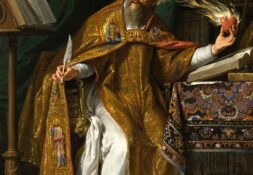
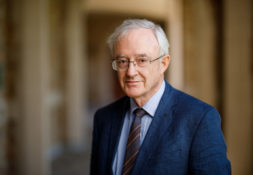
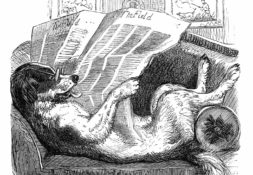
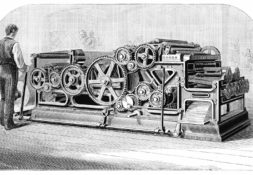
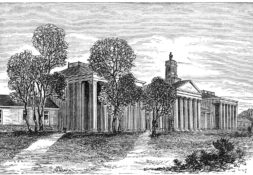

Leave a Reply